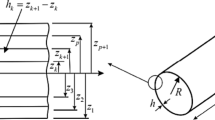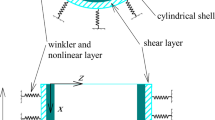Abstract
The most frequently encountered structure in design is the cylindrical shell. This study analyzed, methods to optimize the design of a composite cylindrical shell against buckling and failure. Buckling and failure characteristics were investigated when an axial load, a torsional load or both loads were applied simultaneously. Optimization of the composite cylindrical shell was performed with respect to a loading boundary condition using a genetic algorithm. All analyses were performed numerically using finite element analysis. By optimizing the layer angle of the laminate composite, the buckling load of the cylindrical shell was maximized. The thinwalled shell with the strongest resistance to failure was achieved by optimizing the angle of the composite layer based on the Tsai- Wu composite failure theory. The optimized composite cylindrical shell exhibited significantly improved mechanical properties compared to the conventional design.
Similar content being viewed by others
Abbreviations
- N k :
-
shape function
- V n k :
-
unit normal vector of shell surface
- u, v, w:
-
displacement component
- t R :
-
external virtual work
- 0tSij:
-
2nd Piola-Kirchhoff stress
- [K L ]:
-
linear stiffness matrix
- [K NL ]:
-
nonlinear stiffness matrix
- {F}:
-
internal force vector
- C ijrs :
-
material stiffness tensor
- δ ij :
-
Kronecker delta
- [T sh ]:
-
transformation matrix
- λ :
-
eigenvalue
- F ij :
-
Tsai-Wu failure coefficient
- f :
-
Tsai-Wu failure index
- X t :
-
tension strength in x-direction
- X c :
-
compression strength in x-direction
- S xy :
-
shear strength in x-y plane
- θ i :
-
layer angle
- σ ij :
-
stress tensor
References
Haftka, R. T. and Gürdal, Z., “Elements of Structural Optimization,” Kluwer Academic Publishers, 1992.
Riche, L. R. and Haftka, R. T., “Optimization of Laminate Stacking Sequence for Buckling Load Maximization by Genetic Algorithm,” AIAA Journal, Vol. 31, No. 5, pp. 951–956, 1993.
Spallino, R. and Thierauf, G., “Thermal Buckling Optimization of Composite Laminates by Evolution Strategies,” Computer and Structures, Vol. 78, No. 5, pp. 691–697, 2000.
Hyer, M. W. and Charette, R. F., “Innovative Design of Composite Structures: Further Studies in the Use of a Curvilinear Fiber Format to Improve Structural Efficiency,” Virginia Polytechnic Inst. and State Univ., college of engineering, Blacksburg, VA, Rept. VPI-E-88-8, 1988.
Forys, P., “Optimization of Cylindrical Shells Stiffened by Rings Under External Pressure including their Post-buckling Behaviour,” Thin-Walled Structures, Vol. 95, pp. 231–243, 2015.
Morozov, E. V., Lopatin, A. V., and Nesterov, V. A., “Finite-element Modeling and Buckling Analysis of Anisogrid Composite Lattice Cylindrical Shells,” Composite Structures, Vol. 93, No. 2, pp. 308–323, 2011.
Taheri-Behrooz, F., Omidi, M., and Shokrieh, M. M., “Experimental and Numerical Investigation of Buckling Behavior of Composite Cylinders with Cutout,” Thin-Walled Structures, Vol. 116, pp. 136–144, 2017.
Rouhi, M., Ghayoor, H., Hoa, S. V., and Hojjati, M., “Multiobjective Design Optimization of Variable Stiffness Composite Cylinders,” Composites: Part B, Vol. 69, pp. 249–255, 2015.
Khakimova, R., Zimmermann, R., Wilckens, D., Rohwer, K., and Degenhardt, R., “Buckling of Axially Compressed CFRP Truncated Cones with Additional Lateral Load: Experimental and Numerical Investigation,” Composite Structure, Vol. 157, pp. 436–447, 2016.
Kim, J. H., Shin, K. B., and Kim, J. S., “Optimum Design on Suspension Joint Parts of GFRP Composite Bogie Frame with Hshaped Side Beams for Urban Railway Trains,” Int. J. Precis. Eng. Manuf., Vol. 13, No. 1, pp. 71–76, 2012.
Cho, H. K., “Design Optimization of Laminated Composite Plates with Static and Dynamic Considerations in Hygrothermal Environments,” Int. J. Precis. Eng. Manuf., Vol. 14, No. 8, pp. 1387–1394, 2013.
Lee, S. M., and Han, S. Y., “Topology Optimization Scheme for Dynamic Stiffness Problems Using Harmony Search Method,” Int. J. Precis. Eng. Manuf., Vol. 17, No. 9, pp. 1187–1194, 2016.
Kim, N. H., Kim, J. M., Khatib, O., and Shin, D., “Design Optimization of Hybrid Actuation Combining Micro-Mini Actuators,” Int. J. Precis. Eng. Manuf., Vol. 18, No. 4, pp. 519–527, 2017.
Goldberg, D. E., Deb, K., and Clark, J. H., “Genetic Algorithms, noise, and the Sizing of Populations,” Complex Systems, Vol. 6, pp. 333–362, 1992.
Gen, M. and Cheng, R., “Genetic Algorithms and Engineering Optimization,” Wiley-Interscience, 2000.
Michalewicz, Z., “Genetic Algorithms + Data Structures = Evolution,” Springer-Verlag, 1996.
Goldberg, D. E., “Genetic Algorithms in Search,” Optimization and Machine Learning,” Addison Wesley, 1989.
Bath, K. J., “Finite Element Procedures in Engineering Analysis,” Prentice-Hall, 1982.
Cho, H. K., “Optimum Design of Composites,” Ph.D. Thesis, University of Wisconsin-Madison, pp. 123–187, 2016.
Ansys Users Manual, http://www.ansys.com
Ehsani, A., and Rezaeepazhand, Jalil., “Stacking Sequence Optimization of Laminated Composite Grid Plates for Maximum Buckling Load Using Genetic Algorithm,” International Journal of Mechanical Science, Vol. 119, pp. 97–106, 2016.
Vosoughi, A. R., Darabi, A., Anjabin, N., and Topal, U., “A mixed Finite Element and Improved Genetic Algorithm Method for Maximizing Buckling Load of Stiffened laminated Composite Plates,” Aerospace Science and Technology, Vol. 70, pp. 378–387, 2017.
Kazemi, M., and Verchery, G., “Design of Composite Laminated Plates for Maximum Buckling Load with Stiffness and Elastic Modulus Constraints,” Composite Structures, Vol. 148, No. 15, pp. 27–38, 2016.
Author information
Authors and Affiliations
Corresponding author
Rights and permissions
About this article
Cite this article
Cho, HK. Optimization of laminated composite cylindrical shells to maximize resistance to buckling and failure when subjected to axial and torsional loads. Int. J. Precis. Eng. Manuf. 19, 85–95 (2018). https://doi.org/10.1007/s12541-018-0010-6
Received:
Revised:
Accepted:
Published:
Issue Date:
DOI: https://doi.org/10.1007/s12541-018-0010-6




